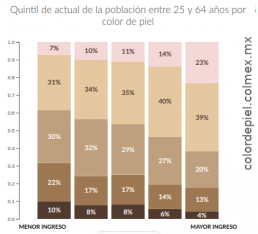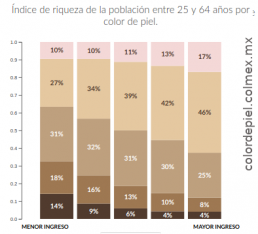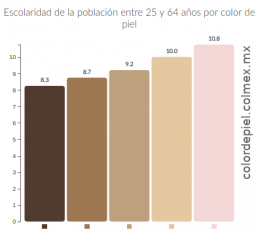Mexico is a country with great cultural and social diversity that is reflected in multiple phacets. The variety of skin tones presented by the population of Mexico is one of the ways in which our history and diversity is manifested. In our country we talk about the way in which skin color affects the way people live, work, study and interact with each other daily.
In a paper presented by the College of Mexico, it is observed that the skin color on the PEARL scale has a relationship with the population schooling and their income. It is observed that there are education and income privileges that are correlated with skin tone: The quintiles of the population with the highest percentage of lighter skin tones have higher educational levels and higher incomes.
How do we measure skin color?
From the skin color studies observations, we focus on analyzing the behavior of the population with the highest income to find some correlation between the skin color and the richness of this sub-group of the population. In particular, we want to know how the skin color of the people who earn the most in Mexican companies is distributed and if there is any relationship with skin color.
To do this, we used the list of the 500 most important companies in Mexico published by the magazine Expansión in its 2019 edition. We take into account that the people who work as CEOs of these companies must belong to the highest income group reported by the work of ColMex . From the list, we searched for the names of the CEOs, we found photographs of these people and then analyzed their skin color. From the 500 companies on the list we obtained photographs of 443 people in charge of the management of the companies.
Then, using these photographs we analyzed the skin color of these people in order to obtain the average tone of each of them. For this, we employed the algorithm presented in the article “Skin detection based on image color segmentation with histogram and K-means clustering” (Buza, Akagic, Omanovic. 2017).
The article presents a method for the detection of skin color, with very low computational cost and serving as a pre-processing step for more advanced methods. The method itself works with the RGB code of each pixel in the image, thus obtaining data on the lighting, color saturation and distance of each pixel. This information is used to determine if the pixel can be classified as skin.

The previous work finds that the results of the proposed method are favorable in the case of images of faces with simple backgrounds and good lighting, regardless of the ethnicity of the person. We applied the algorithm to the photographs of the CEOs of the most important companies in Mexico and then analyzed the skin color and its relationship with the annual sales of the company or the ranking of the company in the magazine list.
The results of the application of the previous method were included in a database where we added information on sales, company type, skin color, sex, average skin color, RGB index and company ranking. Using this information, relationships between the variables presented in this work are obtained
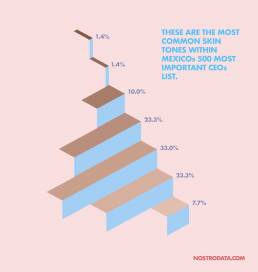
Among the results obtained, we observe that 60% of the CEOs of the sample are in the medium skin tone category, while 30% are in some category of lighter skin tone. 10% of the sample falls withinin the range of dark tones. It is worth noting that, although it was expected to find a population similar to that reported by the College of Mexico ( ColMex ), we observe that in the 443 companies analyzed, the skin color of CEOs tends to be a darker skin tone than expected.

On the other hand, we observe that the companies that have higher average sales correspond to those that have darker skin tone CEOs, which represent less than 3% of the sample.
From the above we conclude that although a large population of people with clear complexion is observed in the sample of CEOs, the skin color is not significant to determine the profits of a company.
There are clearly other factors to consider when talking about corporate and company earnings at these levels. One of the most interesting results is the extreme abundance of men at these levels of work.
What does a CEO look like?
In addition to obtaining the skin color, we took on the task of extracting facial characteristics of the CEOs from the photographs obtained. When combined we get an averaged image that allows you to visualize the “average” attributes of a CEO’s face. The most important characteristics that can be obtained from these images are skin color and gender.
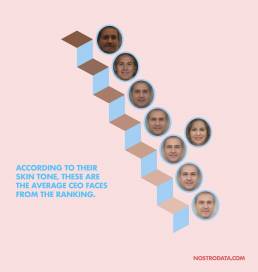
We used the OpenCV package to extract the facial attributes of each image from our database that are then superimposed to obtain the final image of the faces presented below.
Gender vs Skin Tone
The most important conclusion, not surprising at all, is that in Mexico the most important companies are run by men. This speaks of important gender factors that need to be analyzed that influence women’s access to high-level positions. As we mentioned at the beginning, Mexico is a diverse and multifaceted country. We are at a historical and social point where Mexican society begins to become aware of the discrimination suffered in our country due to various factors.
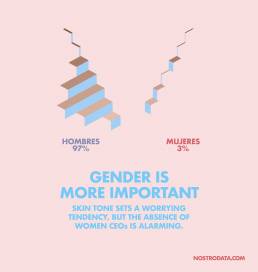
Putting data on the table and analyzing the underlying reasons for what we see in them helps us to develop better strategies to reflect that diversity that makes us feel proud of Mexico.

 Español
Español